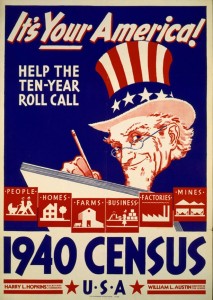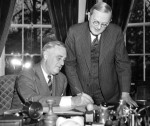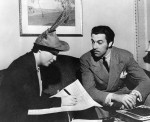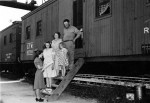 The United States has taken a census of the population every 10 years without fail since 1790. Census figures determine how many seats in the House of Representatives are allocated to each state. The first census takers were federal marshals who went door to door recording the name of the head of the household and the number of people in each household. Native Americans were not counted. Only three out of five slaves were counted.
The United States has taken a census of the population every 10 years without fail since 1790. Census figures determine how many seats in the House of Representatives are allocated to each state. The first census takers were federal marshals who went door to door recording the name of the head of the household and the number of people in each household. Native Americans were not counted. Only three out of five slaves were counted.
(This is the infamous Three-Fifths Compromise, which stipulated that just three out of five slaves in every state would be counted for the purposes of determining population and thus the number of seats in the House. Slaveholding states wanted all their slaves to count so they could dominate the legislature; non-slaveholding states wanted no slaves counted since they didn’t have the vote, citizenship or even the right not to be sold like so much livestock, and would give the slave states disproportionate power in the House. James Madison suggested the three-fifths figure which was eventually adopted by the Constitutional Convention.)
 Throughout the whole of the 19th century and half of the 20th, political districts were responsible for sending out census takers, called enumerators, armed with forms and pencils to canvass door to door. The enumerators would return completed forms to the precinct office where they’d be entered in ink in bound ledger books. This is why historical census records have all kinds of transcription errors and misspellings, not to mention many omissions particularly in rural areas where enumerators would have to travel for miles to find remote farms, many of whose inhabitants made themselves intentionally unreachable. Starting with the 1950 census, enumerators were replaced with forms mailed out to every address on file with the United States Post Office.
Throughout the whole of the 19th century and half of the 20th, political districts were responsible for sending out census takers, called enumerators, armed with forms and pencils to canvass door to door. The enumerators would return completed forms to the precinct office where they’d be entered in ink in bound ledger books. This is why historical census records have all kinds of transcription errors and misspellings, not to mention many omissions particularly in rural areas where enumerators would have to travel for miles to find remote farms, many of whose inhabitants made themselves intentionally unreachable. Starting with the 1950 census, enumerators were replaced with forms mailed out to every address on file with the United States Post Office.
By law, all individual census records are sealed for 72 years. Summaries and statistical reports are released as soon as the data is tabulated, but the information about John Smith at 100 Maple Lane is kept under wraps for three score and 12. In the past, the population schedules were only made available on microfilm. With the rise of the Internet and the explosion of online genealogical research, many of those historical census records have been digitized, but researchers had to drag their cookies to a National Archives and Records Administration branch office and go through all the microfilm by hand.
The 1940 Census, its 72 years come round at last, slouches towards the Internet to be born. Now for the first time, census records will be released online. Bookmark this website: 1940 Census Archives, and return to it on April 2nd at 9:00 AM to see the 1940 Census in all its glory.
 It really is glorious. This is the only census taken during Franklin Roosevelt’s many presidential administrations and the only one to tabulate the statistical realities of the Great Depression. It included new questions about employment, income, and home ownership vs. renting (see a PDF of a blank 1940 form here), which at the time caused some distrust of the census requiring a major media campaign to reassure Americans their answers would be kept in utmost confidence and framing the census as patriotic duty.
It really is glorious. This is the only census taken during Franklin Roosevelt’s many presidential administrations and the only one to tabulate the statistical realities of the Great Depression. It included new questions about employment, income, and home ownership vs. renting (see a PDF of a blank 1940 form here), which at the time caused some distrust of the census requiring a major media campaign to reassure Americans their answers would be kept in utmost confidence and framing the census as patriotic duty.  Cesar Romero, the future Joker to Adam West’s Batman, pitched the census in a public service film. Pictures of FDR filling in the census form were publicized all over the country.
Cesar Romero, the future Joker to Adam West’s Batman, pitched the census in a public service film. Pictures of FDR filling in the census form were publicized all over the country.
One not-so-small caveat: the data has not been name indexed yet. The census records are indexed by enumeration district — the geographic area a single census taker could cover in two weeks in an urban center, or in one month in a rural location. Commercial ancestry websites Ancestry.com and FamilySearch.org have announced that they’ll create a name index (plus indexes of all the other fields too), but it’ll be some time before they’re done. (Ancestry.com is a pay service, but they’ll allow free access to their index and proprietary search tools through the end of 2013. FamilySearch.org is run by the Mormon church. Access is free and you can even help index the census.) If you want to locate a person using the government website, you’ll have to know where the person lived in order to track down his or her census information.
 If you’d like to be ready to hit the records running, you can figure out which enumeration district the person you’re researching lived in. Go to the National Archives’ online public access search page and type “1940 enumeration district descriptions for [city or county]” (without the quotation marks). You’ll get any written descriptions of 1940 Census enumeration districts that include the place you searched for, plus any maps that include it. Track down the address and you’ll see a two part number separated by a hyphen labeling the area. That’s the enumeration district number.
If you’d like to be ready to hit the records running, you can figure out which enumeration district the person you’re researching lived in. Go to the National Archives’ online public access search page and type “1940 enumeration district descriptions for [city or county]” (without the quotation marks). You’ll get any written descriptions of 1940 Census enumeration districts that include the place you searched for, plus any maps that include it. Track down the address and you’ll see a two part number separated by a hyphen labeling the area. That’s the enumeration district number.
I searched for the tiny town my father was born in just three years before the census and I got three written documents and two maps. I now have both of their enumeration district numbers good to go so I can look up my adorable toddling parents on April 2nd. :boogie:
If you’re daunted by the prospect, check your local public library for resources. This Michigan public library, for instance, is offering a workshop on locating your family members on the census two days after the release.
For a three minute period overview of the census, see this film created as part of the training for enumerators. Notice the strong emphasis on the confidentiality of the data and on how a full and honest response is the duty of all patriotic citizens.
[youtube=http://www.youtube.com/watch?v=cImIlPSuyR8&w=430]
The National Archives YouTube channel has three other videos from this film that go into further detail on the census-taking process. They’re a tad on the dry side, but fascinating for genealogists, statisticians, social historians, archivists and other assorted nerdly species.